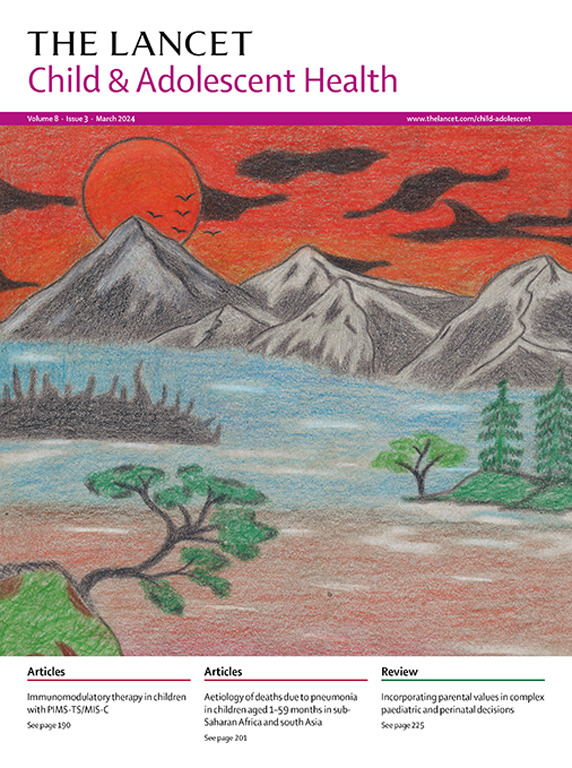Long-term efficacy and safety of sofosbuvir-based direct-acting antiviral regimens in paediatric patients with hepatitis C virus infection: an international registry study
IF 19.9
1区 医学
Q1 PEDIATRICS
引用次数: 0
Abstract
Background
Direct-acting antiviral treatment is associated with high rates of sustained virological response and has a favourable safety profile in children aged 3–17 years with chronic hepatitis C virus (HCV) infection, but data describing the durability of sustained virological response and its effects on growth and sexual development are needed. This study aimed to assess the efficacy and long-term effects of sofosbuvir-based direct-acting antiviral regimens on growth and development in the paediatric population.
Methods
In this international, multicentre, observational registry study, children aged 3–17 years with HCV who received sofosbuvir plus ribavirin, ledipasvir plus sofosbuvir with or without ribavirin, sofosbuvir plus velpatasvir, or sofosbuvir plus velpatasvir plus voxilaprevir in previous clinical trials were eligible for follow-up of growth and sexual development parameters for up to 5 years. Registry baseline was documented as the last follow-up visit under the parent study protocol and follow-up consisted of clinical visits every 6 months for the first 2 years and every 12 months thereafter for up to 5 years, during which symptom-directed physical examination, height and weight measurements, Tanner pubertal stage assessment, procedure-related adverse events documentation, and blood sampling collection were completed. The primary endpoints were changes, relative to baseline, in height, weight, BMI Z scores, and Tanner pubertal stage. Height, weight, BMI, and corresponding percentiles and Z scores were summarised using descriptive statistics. The study was registered at ClinicalTrials.gov (NCT02510300).
Findings
Between October 2015 and June 2021, 461 participants were enrolled in the registry. 426 (92%) participants had at least one post-baseline assessment and were included in the analysis. 93 (20%) participants were previously treated with sofosbuvir plus ribavirin, 192 (42%) with ledipasvir plus sofosbuvir with or without ribavirin, 158 (34%) with sofosbuvir plus velpatasvir, and 18 (4%) with sofosbuvir plus velpatasvir plus voxilaprevir. Most participants included in the analysis were female (247 [58%] participants; sex assigned at birth) and White (342 [80%] participants). The most common HCV genotypes were GT1 (281 [66%] participants) and GT3 (88 [21%] participants). Clinical assessments continued until January 2023. The median follow-up was 3·7 years (IQR 2·7–4·6) among the 426 participants, 302 (71%) of whom completed at least 3 years of follow-up. 424 (>99%) of 426 participants had previously achieved sustained virological response during their parent studies. With a mean age of 12 years (SD 4·1) at baseline, the median change in median Z scores during follow-up was 0·0 (IQR −0·2 to 0·4) for height, 0·1 (−0·3 to 0·5) for weight, and 0·0 (−0·3 to 0·5) for BMI. Increases in Tanner stage were consistent with age, regardless of sex or which secondary sexual characteristic was assessed.
Interpretation
No change in growth or sexual development was detected during prolonged follow-up of paediatric patients who had completed treatment with sofosbuvir-based direct-acting antivirals for chronic HCV. Prolonged clinical follow-up of children who have achieved sustained virological response might not be necessary.
Funding
Gilead Sciences.
基于索非布韦的直接抗病毒治疗方案在小儿丙型肝炎病毒感染患者中的长期疗效和安全性:一项国际注册研究
背景:直接抗病毒治疗与持续病毒学应答率高相关,并且在3-17岁慢性丙型肝炎病毒(HCV)感染的儿童中具有良好的安全性,但需要描述持续病毒学应答的持久性及其对生长和性发育的影响的数据。本研究旨在评估基于索非布韦的直接作用抗病毒方案对儿科人群生长发育的疗效和长期影响。方法在这项国际、多中心、观察性登记研究中,3-17岁的HCV儿童在之前的临床试验中接受索非布韦加利巴韦林、雷地帕韦加索非布韦加利巴韦林或不加利巴韦林、索非布韦加维帕他韦或索非布韦加维帕他韦加沃西拉韦的治疗,有资格接受长达5年的生长和性发育参数随访。登记基线记录为家长研究方案下的最后一次随访,随访包括前2年每6个月一次的临床随访,此后长达5年每12个月一次的临床随访,在此期间完成症状导向的体格检查、身高和体重测量、Tanner青春期阶段评估、手术相关不良事件记录和血样采集。主要终点是相对于基线的身高、体重、BMI Z评分和Tanner青春期阶段的变化。身高、体重、BMI及其相应的百分位数和Z分数采用描述性统计进行汇总。该研究已在ClinicalTrials.gov注册(NCT02510300)。研究结果:2015年10月至2021年6月期间,461名参与者登记在册。426名(92%)参与者至少进行了一次基线后评估,并被纳入分析。93名(20%)受试者先前接受索非布韦加利巴韦林治疗,192名(42%)受试者接受雷地帕韦加索非布韦加利巴韦林或不加利巴韦林治疗,158名(34%)受试者接受索非布韦加维帕他韦治疗,18名(4%)受试者接受索非布韦加维帕他韦加沃西拉韦治疗。大多数被纳入分析的参与者是女性(247[58%]参与者;出生性别)和White(342[80%]参与者)。最常见的HCV基因型是GT1(281例[66%]参与者)和GT3(88例[21%]参与者)。临床评估持续到2023年1月。426名参与者的中位随访时间为3.7年(IQR为2.7 - 4.6),其中302人(71%)完成了至少3年的随访。426名参与者中有424名(99%)先前在其母体研究中获得了持续的病毒学应答。基线时平均年龄为12岁(SD为4.1),随访期间中位Z评分的中位数变化为:身高为0 (IQR为- 0.2 ~ 0.4),体重为0 (IQR为- 0.3 ~ 0.5),BMI为0(- 0.3 ~ 0.5)。坦纳期的增加与年龄一致,与性别或第二性征的评估无关。在完成索非布韦直接作用抗病毒药物治疗慢性HCV的儿科患者的长期随访中,未发现生长或性发育的变化。对已取得持续病毒学反应的儿童进行长期临床随访可能没有必要。FundingGilead科学。
本文章由计算机程序翻译,如有差异,请以英文原文为准。
求助全文
约1分钟内获得全文
求助全文
来源期刊

Lancet Child & Adolescent Health
Psychology-Developmental and Educational Psychology
CiteScore
40.90
自引率
0.80%
发文量
381
期刊介绍:
The Lancet Child & Adolescent Health, an independent journal with a global perspective and strong clinical focus, presents influential original research, authoritative reviews, and insightful opinion pieces to promote the health of children from fetal development through young adulthood.
This journal invite submissions that will directly impact clinical practice or child health across the disciplines of general paediatrics, adolescent medicine, or child development, and across all paediatric subspecialties including (but not limited to) allergy and immunology, cardiology, critical care, endocrinology, fetal and neonatal medicine, gastroenterology, haematology, hepatology and nutrition, infectious diseases, neurology, oncology, psychiatry, respiratory medicine, and surgery.
Content includes articles, reviews, viewpoints, clinical pictures, comments, and correspondence, along with series and commissions aimed at driving positive change in clinical practice and health policy in child and adolescent health.
 求助内容:
求助内容: 应助结果提醒方式:
应助结果提醒方式:


